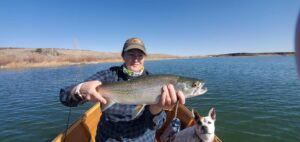When we first get into the sport of fly fishing, we usually end up with a floating line. These work great for dry fly fishing, nymphing and midge fishing under an indicator in lakes. But, there are often times when we need to cover depth and strip streamers and nymphs. When fishing lakes having a variety of sinking lines will greatly increase your catch.
You can buy sinking lines in everything from Intermediate to Type VII. An Intermediate line sinks about 1/2″ to 1″ per second and types II through VII sink in accordance with their weight number. For example a type II will sink two inches per second and a type III will sink three inches per second, etc. Types II through VII are considered density compensated and the tip will sink faster than the rest of the line which gives you better feel between you and the fish since there isn’t a bow in the line.
I am not a huge fan of sink tip lines and find that they don’t do as well as full sinking lines. I also don’t recommend adding sinking tips to your floating line. While it is a cheap way to go it isn’t near as effective.
As you can imagine, the faster the sink, the deeper you are going to be able to fish. There are times when fish are sitting deep and times when they are within the first few feet of the surface. This is why it is important to have lines that stay shallow and lines that will get deep. Intermediate and Type II lines will stay within the shallower zones longer if you need to use a slow retrieve.
So, if you have a floating line, an Intermediate, type III and type V you can pretty much cover any depth you need. You will greatly improve your catch if you can increase your depth.
